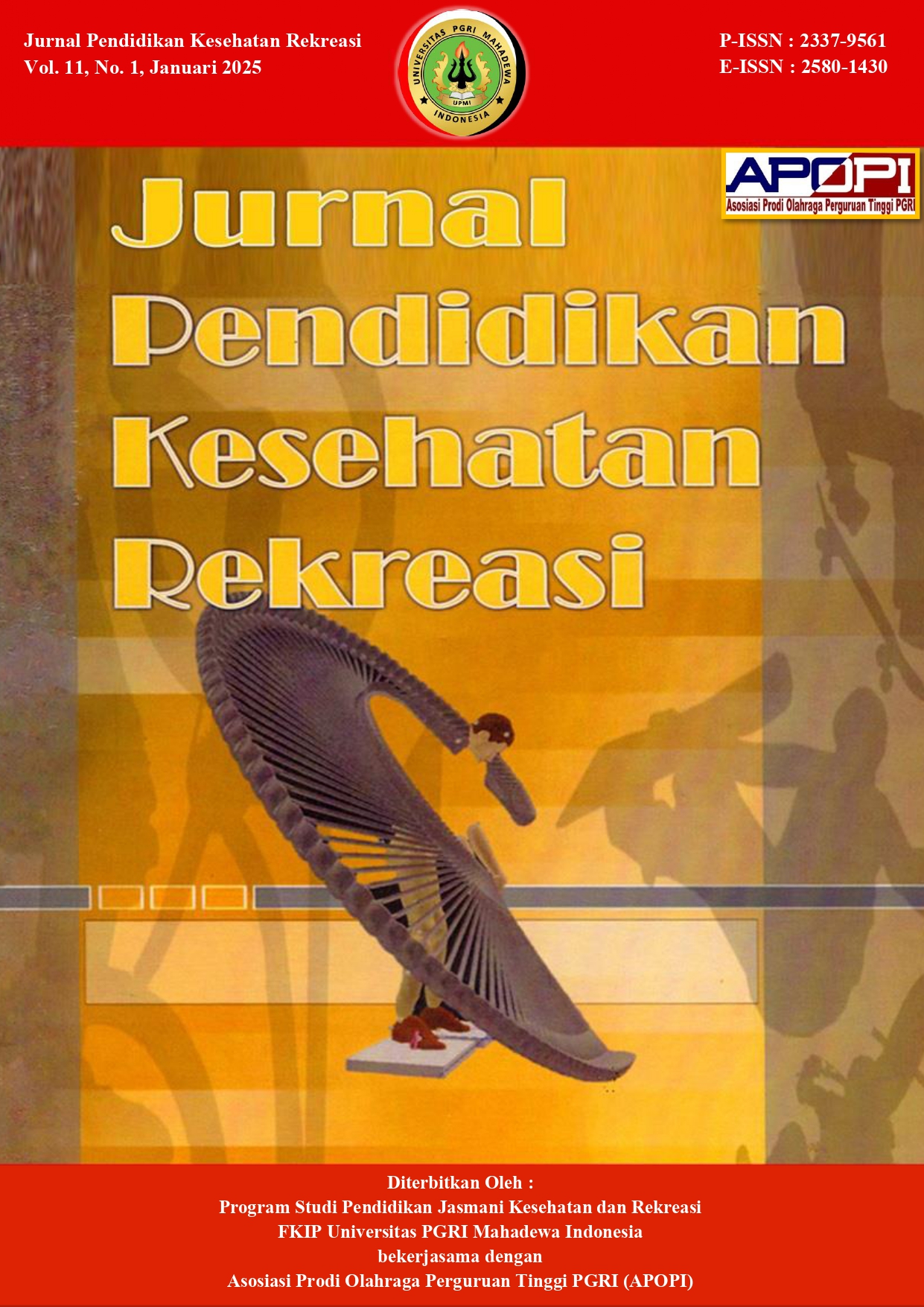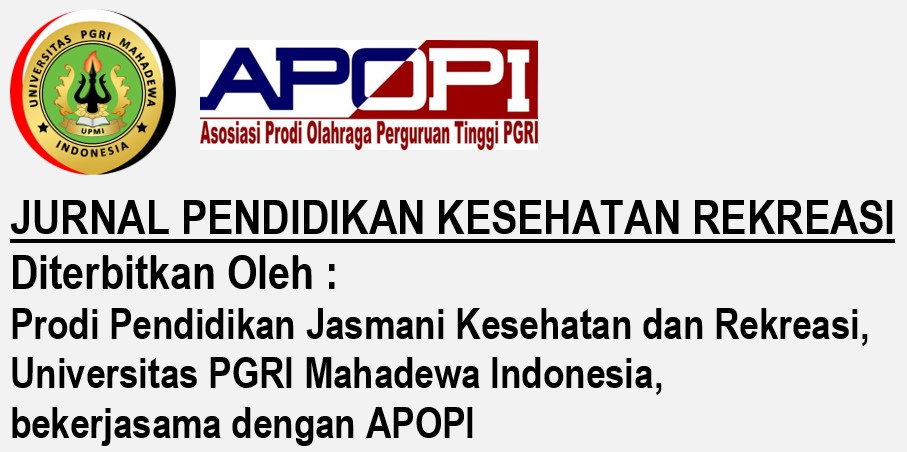Integrasi Teknologi Wearable Fitness Tracker pada Pembelajaran Pendidikan Jasmani dalam Meningkatkan Keaktifan dan Kebugaran Siswa
DOI:
https://doi.org/10.59672/jpkr.v11i1.4238Keywords:
teknologi, fitness tracker, keaktifan, kebugaranAbstract
Teknologi mengalami kemajuan sangat pesat di beberapa tahun terakhir. Termasuk dalam dunia pendidikan dan keolahragaan. Namun kenyataannya belum banyak integrasi teknologi yang diterapkan sebagai pendukung utamanya pada pembelajaran pendidikan jasmani di sekolah. Penelitian ini bertujuan mengkaji pengaruh teknologi wearable fitness tracker terhadap peningkatan keaktifan dan kebugaran siswa. Tahapan metode penelitian dilakukan mulai dari pengambilan data pre-test keaktifan dan kebugaran siswa kemudian dilanjutkan dengan penerapan integrasi teknologi wearable fitness tracker dalam pembelajaran selama 6 minggu. Selanjutnya dilakukan pengambilan data posttest yaitu keaktifan dan kebugaran. Hasil penelitian ini menunjukkan bahwa penggunaan fitness tracker dapat meningkatkan keaktifan dan kebugaran siswa. Kesimpulan penelitian ini yaitu penggunaan teknologi wearable fitness tracker dalam pembelajaran dapat meningkatkan keaktifan dan kebugaran siswa, sehingga penting kiranya setiap sekolah menyediakan sarana yang inovatif dan modern untuk digunakan dalam pembelajaran.
Downloads
References
Almusawi, H. A., Durugbo, C. M., & Bugawa, A. M. (2021). Innovation in physical education: Teachers’ perspectives on readiness for wearable technology integration. Computers & Education, 167, 104185. https://doi.org/https://doi.org/10.1016/j.compedu.2021.104185
Au, W. W., Recchia, F., Fong, D. Y., Wong, S. H. S., Chan, D. K. C., Capio, C. M., Yu, C. C. W., Wong, S. W. S., Sit, C. H. P., Ip, P., Chen, Y. J., Thompson, W. R., & Siu, P. M. (2024). Effect of wearable activity trackers on physical activity in children and adolescents: a systematic review and meta-analysis. The Lancet Digital Health, 6(9), e625–e639. https://doi.org/10.1016/S2589-7500(24)00139-0
Chu, S. L., Garcia, B. M., & Rani, N. (2023). Wearable Technologies for Learning Research on Wearable Technologies for Learning: A Systematic Review. Frontiers, 8. https://doi.org/10.3389/feduc.2023.1270389
Creaser, A. V., Frazer, M. T., Costa, S., Bingham, D. D., & Clemes, S. A. (2022). The Use of Wearable Activity Trackers in Schools to Promote Child and Adolescent Physical Activity: A Descriptive Content Analysis of School Staff’s Perspectives. International Journal of Environmental Research and Public Health, 19(21). https://doi.org/10.3390/ijerph192114067
Cui, Z., Song, Y., & Du, X. (2024). Multilevel modeling of technology use, student engagement, and fitness outcomes in physical education classes. Frontiers in Psychology, 15. https://doi.org/10.3389/fpsyg.2024.1458899
Indra Kusuma, A., Emir Rizkanto, B., Rangga, B., Rentika Hadi, S., & Hanafi, M. (2022). Pengaturan Pola Istirahat Dalam Masa Pandemi Covid 19: Vol. II (Issue 2)
Jastrow, F., Greve, S., Thumel, M., Diekhoff, H., & Süßenbach, J. (2022). Digital technology in physical education: a systematic review of research from 2009 to 2020. In German Journal of Exercise and Sport Research (Vol. 52, Issue 4, pp. 504–528). Springer Science and Business Media Deutschland GmbH. https://doi.org/10.1007/s12662-022-00848-5
Kusuma, A. I., Utamayasa, I. G. D., & Putra, I. B. (2023). Efektifitas Teknologi Sensor Alat Olahraga Neuro Dance pada Simulator dengan Menggunakan Smart Watch terhadap Heart Rate, Tekanan Darah dan Pencegahan Resiko Obesitas. Jurnal Pendidikan Kesehatan Rekreasi, 9(2), 217–224. https://doi.org/10.5281/zenodo.8088193
Martin, N., & Hultman, R. (2022). Applicability of Fitness trackers in the Physical Education of Fifth- and Sixth-Grade Students. Journal of Physical Education, Recreation & Dance, 93(6), 29–34. https://doi.org/10.1080/07303084.2022.2081272
Marttinen, R., Landi, D., Fredrick, R. N., & Silverman, S. (2020). Wearable digital technology in PE: Advantages, barriers, and teachers’ ideologies. Journal of Teaching in Physical Education, 39(2), 227–235. https://doi.org/10.1123/JTPE.2018-0240
Saklani MPED Scholar, A., MPED Scholar, A., & Saklani, A. (2023). Integrating technology into physical education: Exploring the dynamics of AI, virtual reality, apps, and wearables for an enhanced educational odyssey. ~ 353 ~ International Journal of Physical Education, Sports and Health, 10(4), 353–358. www.kheljournal.com
Shin, G., Jarrahi, M. H., Fei, Y., Karami, A., Gafinowitz, N., Byun, A., & Lu, X. (2019). Wearable activity trackers, accuracy, adoption, acceptance and health impact: A systematic literature review. Journal of Biomedical Informatics, 93, 103153. https://doi.org/https://doi.org/10.1016/j.jbi.2019.103153
Steel, R. P. (2024). The longitudinal associations between wearable technology, physical activity and self-determined motivation. International Journal of Sport and Exercise Psychology, 22(4), 1030–1047. https://doi.org/10.1080/1612197X.2023.2180067
Stöckel, T., & Grimm, R. (2021). Psychophysiological Benefits of Real-Time Heart Rate Feedback in Physical Education. Frontiers in Psychology, 12. https://doi.org/10.3389/fpsyg.2021.651065
Syafira Pramudya, A., Yuliani Puspitarini, I. D., Dwi Ariyanto, R., Studi Bimbingan dan Konseling, P., & Keguruan dan Ilmu Pendidikan, F. (2022). Validitas dan Reliabilitas Skala Keaktifan Belajar pada Siswa Kelas XI di SMK PGRI 4 Kediri The Validity and Reliability of The Learning Activity Scale in Class XI Students at SMK PGRI 4 Kediri. Kediri : Universitas PGRI Kediri
Utomo, G. M., Kusuma, A. I., Putra, I. B., Utamayasa, I. G. D., & Sari, M. R. (2024). Peran Jalan dan Senam Aerobic Low Impact terhadap Heart Rate dan IMT bagi Guru Perempuan. Jurnal Pendidikan Kesehatan Rekreasi, 10(2), 281–288. https://doi.org/10.59672/jpkr.v10i2.3625
Xu, Y., Peng, J., Jing, F., & Ren, H. (2024). From wearables to performance: how acceptance of IoT devices influences physical education results in college students. Scientific Reports, 14(1), 23776. https://doi.org/10.1038/s41598-024-75071-3
Zhang, W., Xiong, K., Zhu, C., Evans, R., Zhou, L., & Podrini, C. (2024). Promoting child and adolescent health through wearable technology: A systematic review. Digital Health, 10, 20552076241260508. https://doi.org/10.1177/20552076241260507
Downloads
Published
How to Cite
Issue
Section
License
Copyright (c) 2025 Muhammad Wahyono , Ismawandi Bripandika Putra , Gatot Margisal Utomo , Angga Indra Kusuma

This work is licensed under a Creative Commons Attribution-NonCommercial-ShareAlike 4.0 International License.
Jurnal Pendidikan Kesehatan Rekreasi is published under the terms of Creative Commons Attribution 4.0 International License / CC BY NC SA 4.0. This license permits others to copy, distribute, modify, and create derivative works for non-commercial purposes only


































